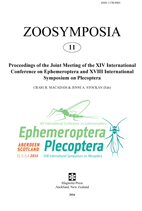Abstract
The use of non-invasive techniques to study a wide array of zoological specimens has been increasing considerably during the 21st century. Among these techniques, micro-computed X-ray tomography (μ-CT) is gaining much attention. This method may allow access to hardly visible and internal structures of valuable specimens (e.g. type specimens) through virtual dissections. We studied two type specimens of Ephemeroptera belonging to the family Heptageniidae using μ-CT; the male lectotype of Epeorella borneonia Ulmer, 1939 (pinned specimen) and the male holotype of Rhithrogeniella ornata Ulmer, 1939 (specimen in ethanol). These specimens are the only male adults known in their respective genera; hence a detailed description of their genitalia could reveal important taxonomic and phylogenetic information. We present here the first-ever μ-CT study of mayfly type specimens, and confirm that male genitalia of R. ornata lack titillators, whereas those of E. borneonia possess a pair of titillators which were concealed within the penis lobes.

